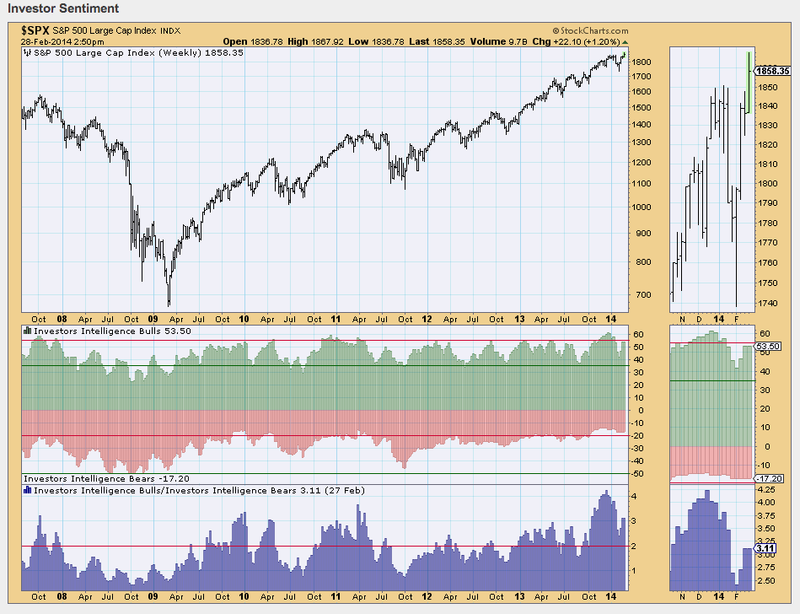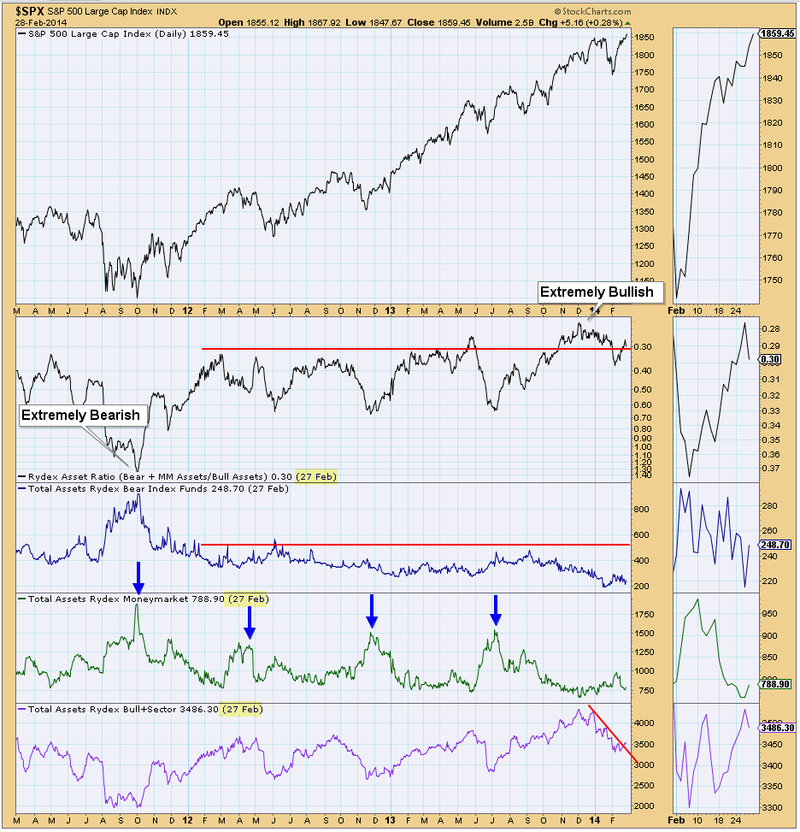The bulls had been dropping out of the ring during the recent correction, but they're baaaaack.
The DecisionPoint Chart Gallery has a section devoted to sentiment. There is the Investor's Intelligence Survey chart with not only the percentage of bulls and bears, but also a bull-bear ratio. And there is the DecisionPoint Rydex Asset Ratio chart. Both illustrate that bullish sentiment is rising
Investor's Intelligence surveys over a hundred independent market newsletters and assesses each author's current stance on the market: bullish, bearish or correction. The results are below in the chart from the DecisionPoint Chart Gallery. For a live version, click on the chart.
Data is collected on Wednesday and published Thursday. I find it interesting that we saw an increase in bulls, almost into top of its range and then we saw a price breakout on Friday. Generally sentiment is contrarian. However, that's why we also use the Bull/Bear ratio. It shows a definite increase, but the disparity between bulls and bears as measured by the ratio isn't as high as it was before the last correction.
Developed by my father Carl Swenlin, the Rydex Asset Ratio is a unique way to measure sentiment. Rydex is an unusual mutual fund company in that it publishes the total dollar amount of assets in each of its funds on a daily basis. This makes it possible for us to analyze sentiment based upon what investors are actually doing with real money. We do this by calculating a daily bear/bull asset ratio and monitoring the relationship between assets in the two types of funds.
Because we don't receive asset information until hours after the close, you should be aware of the date of the last update noted in parentheses. The chart below shows data from Thursday, Feb. 27. (Click it to see Friday's data.)
Let's start at the bottom pane and work our way up. We can see that during the correction money was leaving the Bull+Sector funds. That's not surprising. But what is surprising is that not much has gone back in during the upswing.
Money Market assets has been moving mostly sideways since September of last year. Notice the peaks in Money Market assets tended to coincide with market bottoms. This is logical since investors move assets into cash when they are pessimistic.
The next pane illustrates that assets in bear funds has been relatively even since peaking at the 2011 price bottom.
The Rydex Asset Ratio is produced by dividing the Bear funds plus money market assets by Bull assets. We use a reverse log scale to chart the value of the ratio. If you remember from calculus, if you have a fraction and the denominator gets larger and larger, the overall value approaches zero. So as more and more money moves into the bull funds, the ratio value also approaches zero. Conversely, if the numerator gets larger and larger, the ratio value moves away from zero. Note in the chart that the largest value of the ratio was reached near the 2011 price low and right now the ratio value is very small and is residing in overbought territory, meaning sentiment is very bullish based on where the money is residing.
In conclusion, sentiment in both the survey and Rydex Ratio is very bullish. While sentiment is generally contrarian, neither the Investor's Intelligence ratio nor the Rydex Ratio have reached the extremes that they can. And, we know that today, the market had a breakout and hit new all-time highs. It will be interesting to review the survey next week and watch the changes nightly on the Rydex Assets chart.
Happy Charting,
Erin








